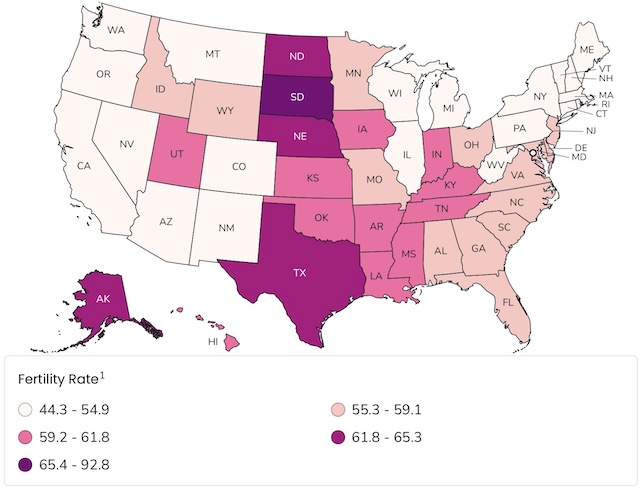On his second day in office, Transportation Secretary Sean Duffy directed federal transportation agencies to “give preference to communities with marriage and birth rates higher than the national average,” to which my friend Bob Poole responded with a profound “huh?” Matthew Yglesias, meanwhile, fretted that this policy could backfire, erroneously claiming that directing funding to low-density communities with higher birth rates would make housing in such communities even more expensive, which would reduce birthrates.
Darker colors show higher fertility rates measured in births per thousand women. Source: CDC. Click image for a larger view.
As I noted in an article published by the Institute for Family Studies, it may seem strange for the Department of Transportation to get involved in family policy, but in fact it already has been involved in such policy for many years through the Federal Transit Administration. That agency’s transit capital grant program (which was specifically cited in Duffy’s memo) favors grants to communities that provide “transit-supportive land use,” meaning zoning and subsidies favoring high-density housing.
Recent economic research has found that the Baby Boom was due, in large part, to federal policies that promoted homeownership. The report didn’t say so, but 94.3 percent of owner-occupied homes in the United States are single-family homes (including mobile homes), while only 5.5 percent are multifamily, so increasing ownership of single-family homes appears to be a good way of increasing fertility.
FTA’s housing policies were based on the explicit assumption that high-density housing in transit corridors would lead to more transit ridership and the implicit assumption that more transit ridership would save energy and reduce greenhouse gas emissions. Neither of these assumptions are true.
Research by the Cascade Policy Institute showed that people living in transit-oriented developments in the Portland area were not significantly more likely to ride transit than those living elsewhere. This is confirmed by the fact that, despite building hundreds of transit-oriented developments, Portland-area transit ridership was declining in the five years before the pandemic.
Data in the National Transit Database also shows that transit is hardly green. Outside of New York and one or two other urban areas, transit uses more energy and emits more greenhouse gases (including emissions from the power plants that supply electricity for electric-powered transit) than the average car or light truck.
Transit-oriented housing is also sometimes claimed to be more affordable housing, but that is a complete lie. As I’ve noted here many times before, the elevators, steel, concrete, and interior non-living areas such as lobbies and hallways all increase the costs of multi-story housing, so the four- to six-story buildings going into most transit-oriented developments cost about twice as much, per square foot, as single-family homes.
Yglesias’ claim that emphasizing low-density housing (which isn’t explicitly mentioned in Duffy’s directive) will only make housing more expensive is valid in regions that have created artificial land shortages using urban-growth boundaries, greenbelts, concurrency requirements, and other growth-management policies. But in other areas, including all of Texas and most parts of other fast-growing states in the Sunbelt, there is plenty of room for all the low-density housing that people want. There is also room for high-density housing if anyone wants to live there and if there are enough such people builders will provide it for them.
Countries colored in browns have 2022 fertility rates (measured in number of children born over an average woman’s lifetime) higher than replacement while those colored blue are not replacing their populations with domestic fertility (but may be doing so through immigration). Source: Wikipedia chart by Korakys. Click image for a larger view.
Fertility rates in other countries, including China, Italy, Russia, South Korea, and other countries have fallen so far that they posse a serious demographic crisis for those economies. Fertility rates are known to drop when agrarian societies become urbanized, but not necessarily below replacement levels.
Fertility rates have fallen to such low levels that the populations of 23 countries are expected to fall by at least 50 percent by 2100. While some reduction in population may have environmental benefits, such dramatic reductions will pose huge economic problems resulting from too few people working and too many in retirement. Many of the countries with ultra-low fertility rates have emphasized mid-rise and high-rise housing and tried to discourage single-family housing.
I don’t think that government policies and government grants should be based on a single parameter, whether it is greenhouse gas emissions or fertility rates. The fertility requirement is only one of several points in Duffy’s directive, others saying that funded projects should be “supported by rigorous cost-benefit requirements and data-driven decisions” and be based on “user-pay models.”
At the same time, low fertility rates are a symptom of government policies gone wrong. As I have endlessly repeated here, regardless of whether they are of child-bearing age, most Americans want to live in single-family homes. In fact, more than 80 percent of the residents of a dozen states that haven’t passed state-wide growth-management laws do live in single-family homes. FTA’s land-use policies were effectively supporting those who want to overturn that preference and get more people into multifamily homes.
The one change I would make to Secretary Duffy’s policy is that it should be based not on recent fertility rates but on projected rates. If a region such as Portland or San Francisco abolishes its urban-growth boundary, that is likely to increase fertility and this should be taken into consideration when handing out federal dollars.










Fertility rate: ‘Jaw-dropping’ global crash in children being born
For want of a “less than” a link was lost. 🙂
The claim that “low fertility rates are a symptom of government policies gone wrong” is completely false. In reality, declining fertility rates are directly linked to increased education, economic opportunity, and contraception for women. Unlike what the AP suggests , single-family homes don’t lead to women to have higher birth rates.
It costs upwards of $310,000 to raise a child to age 18 (so that doesn’t include college expenses). In 2023, nearly a quarter of household income was spent on child care. With massive inflation and houses going for double what they sold for five years ago, is it any wonder people are having fewer children?
“I don’t think that government policies and government grants should be based on a single parameter”
Maybe these federal government grants and most federal policies shouldn’t even exist.
Tumalo Joe,
the financial explanation for low fertility rates has been thoroughly debunked several times over. The rates are falling in all countries that enter modernity despite distinct macroeconomic conditions.
In our distant past, humans were significantly poorer than they are today but managed to procreate at high enough rates.
Even today, the only group that maintains a above replacement level fertility rates across nations is the criminal underclass.
Sketter,
I mentioned this when I wrote, “Fertility rates are known to drop when agrarian societies become urbanized, but not necessarily below replacement levels.” The U.S. fertility rate hovers around replacement of 2.1 children during the life of the average woman. South Korea’s rate of around 1.0 is well below replacement value and must be due to factors other than education and contraception. Cramped housing is one of those factors.
rovingbroker,
Thanks for pointing out those embarrassing HTML mistakes.
WP Anon:
“the financial explanation for low fertility rates has been thoroughly debunked several times over.”
I see one study that claims to debunk this, but I see many other studies that support it. In one recent study, 36% of respondents stated the main reason they hadn’t had children was “Can’t afford,” second only to “Still looking for the right spouse/partner.” A recent NBER working paper suggests “fertility behavior is more forward-looking and sensitive to changes in short-run expectations about the economy than previously thought.” Another recent study in The Economic Journal found in Spain that “economic recession has disrupted the positive trend in fertility that began at he start of this century.” Yes, other factors affect fertility rates, but you can’t casually dismiss economic factors as being “thoroughly debunked” when they haven’t been.
“In our distant past, humans were significantly poorer than they are today but managed to procreate at high enough rates.”
This isn’t an appropriate comparison because our distant ancestors lived had higher mortality rates and different societal structures.
“the only group that maintains a above replacement level fertility rates across nations is the criminal underclass.”
This statement is not supported by evidence. I don’t think you can show that a so-called “criminal underclass” universally maintains above replacement-level fertility rates across all nations.
Tumalo Joe,
Growth in median household income negatively correlates with fertility rates worldwide. This was even true in pre-industrial societies. Also, countries that got wealthiest the fastest also saw the largest fertility declines.
Again, in our distant past, a lack of resources was not at all a reason for limited fertility. It’s simply a recent cope for people who simply don’t want to devote resources to child rearing than alternative uses. And yes, it is 100% an “appropriate comparison.” We see this phenomenon today when developing nations industrialize.
whatever children i might have had were aborted. i was born in raleigh nc (late 60s) and with blind parents my first 16 years were on transit, or cabs or neighbors providing a lift. so my early years were, ah… just hop on a bus with a driver that knew my name, pay a small fare and go where I wanted, 70s and 80s. I expect much different than most. most needs were met with this arrangement. are their cities internationally where density is spawning many child births? is density and birth rates sort of nation dependent?
WordPress_anonymous wrote, “Growth in median household income negatively correlates with fertility rates worldwide.”
Institute for Family Studies tells us, “There’s a common stereotype that poor people have more babies than rich people … This perception, however, is false. In most human societies, poverty does not predict higher fertility, and well-to-do families often have the highest fertility. When families in America have more money, they tend to have more children.”
https://ifstudies.org/blog/more-money-more-babies-whats-the-relationship-between-income-fertility
rovingbroker,
You’re comparing a different topic. The inverse relationship between economic development and fertility rates is between countries longitudinally, not within a single country.
Within wealthy countries, the fertility rates-income relationship is a U-curve parabola, with lower and upper incomes achieving higher fertility rates than the middle class. However, there is a significantly smaller amount of upperclass people in an absolute amount, ultimately leading to that cohort having far fewer children.
Regardless, any poor nation that industrializes will eventually see a dramatic fall in fertility.